2022 UW-River Falls Strawberry Research Update: Replicated Genotype Performance Trial Established
A new 2022 replicated performance trial was established at UW-River Falls earlier this growing season and represents somewhat of a departure from the past; when testing strawberries from other breeding programs was the primary focus in order to determine adaptability to upper Midwest commercial conditions. A secondary benefit was to identify which of these cultivars could be possibly used in and beneficial for the UW-River Falls breeding program. The primary mission for this 2022 trial is to strictly test the elite selections from our breeding program against the standard commercial cultivars for our area and release the most superior for commercial production.
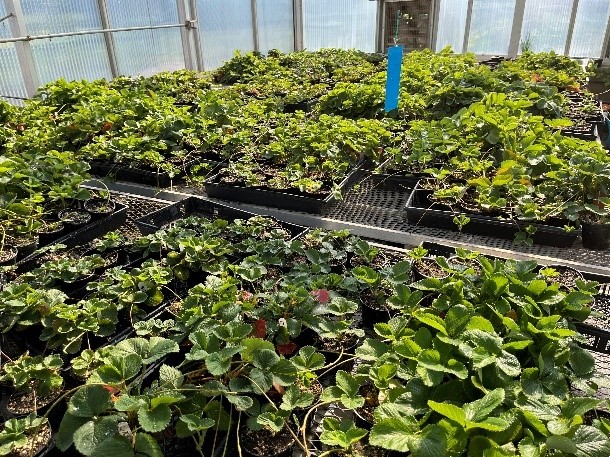
In preparation for this trial, we concentrated on propagation efforts from Fall 2021 to early Spring 2022 in order to generate sufficient quantities of all past elite advanced selections from the breeding program. This involved greenhouse runner-propagating 2,304 plants (64 plants each of 36 advanced selections) that span 21 years of the breeding program (UWRF program in entirety spans 31 years). Greenhouse propagation is not easy under ambient light intensity greenhouse conditions in the winter and early spring, so we grew everything under 18-hr. days(photoperiod), using newly-installed high-intensity LED lighting fixtures specifically designed for optimum strawberry growth in both greenhouses used for fruit research. We also set day temperatures at 800F and nights at 650F. As one might guess, some selections responded much better than others regarding runnering, so trying to keep sufficient greenhouse space available, we gave some propagated plants some cooler time(pseudo-dormancy) while concentrating on the more stubborn genotypes in order to obtain sufficient plants from them. All runner plants were started in 3-4” pots while attached to mother plants, with many runnering and producing secondary to pentinary runner plants. Once sufficient roots had developed, all were separated from their respective mother host plant and then placed on a high nitrogen regime and continued long-day photoperiod.
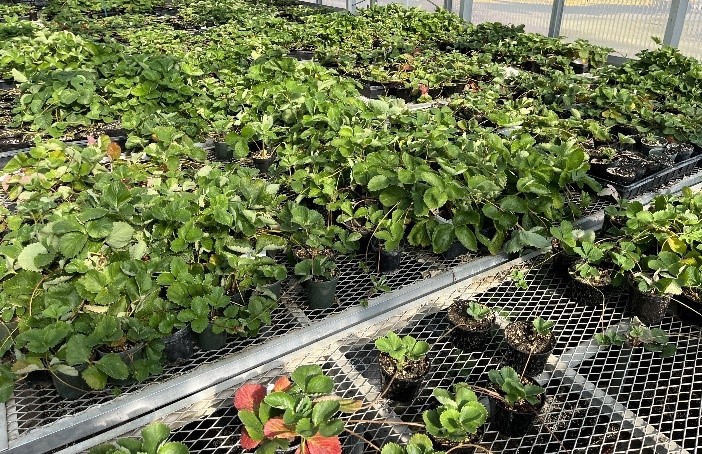
The replicated performance trial site is the University of Wisconsin-River Falls Fruit TREE (Teaching, Research & Extension Education) Facility. The soil type is a Sparta Sandy Loam (sandy, siliceous, mesic Entic Hapludoll) with a 2.1% organic matter and a pH of 7.1. Winter temperatures can reach -42°F (USDA Hardiness zone 3b). Average annual rainfall is approximately 28 in. and the average frost-free growing season is 121 days. The plot area used for establishment of the new strawberry replicated trial was planted with rye prior to 2021. This trial is a semi-randomized complete block and has 4 replications of each entrant. The plots are 16 ft.long with plant spacing at 12 inches apart within. All plots/rows are 4 ft on center and will be allowed to fill in to 18 in. width.
This trial is characterized by 42 genotypes/clones; 6 of which are commercial comparison cultivars: AC Wendy, Annapolis, Honeoye, Brunswick, Cavendish, and Jewel. The advanced selections in trial are as follows (3 numbers in each selection ID are year selection was made, code number for parentage of progeny and seedling number from map in field, like plant number “25” of 47 total seedlings. So, the first selection listed was selected in 2002, had a parentage code of 14 and was seedling # 25 of that family:
| UWRF Advanced Selection | Parentage |
| 02-14-25 | RF98-111-11 (Winona in background) x out-state selection |
| 09-07-9-17 (sel. 2 yrs. later) | RF05-50-30 (L’Acadie and Cabot in background) x Eros |
| 10-12-29 | RF02-14-25 x RF05-50-30 |
| 10-72-42 | Midwest cv. x Cle’ des Champs |
| 10-75-50 | RF04-55-3 (Annapolis in genealogy) x RF02-3-4 (Winona in genealogy) |
| 13-75-6 | British day-neutral x Midwest cv. |
| 13-77-2 | Canadian cv. X RF02-3-4 |
| 13-85-27 | KRS-10 x Midwest cv. |
| 13-88-1 | L’Acadie x Eastern Atlantic cv. |
| 13-92-92 | Eastern cv w/ Cavendish in genealogy x RF02-3-4 |
| 13-92-94 | Same as above |
| 13-107-127 | Tillamook x Midwest cv. |
| 14-32-22 | RF06-68-33(Eros in genealogy) x Midwest cv. |
| 14-34-35 | RF 04-56-54 (USDA sel. B27 in genealogy) x RF05-50-30 |
| 14-36-4 | RF05-7-115(Cavendish & Midwest cv. in genealogy) x KRS-10 |
| 14-44-42 | RF10-69-5(K93-20 from Nova Scotia in genealogy) x Spanish cultivar |
| 14-51-35 | Cavendish x Quebec cv. |
| 14-65-3 | Quebec cv. X 04-55-3 |
| 15-3-27 | RF01-12-19(USDA B27 in genealogy) x RF06-45-5(Seneca part of genealogy) |
| 15-12-3 | RF10-12-29 x Ontario cv. |
| 15-15-15 | RF10-34-21(Jewel & KRS-10 in genealogy) x Midwest cv. |
| 15-25-2 | RF11-28-34(Jewel & RF06-68-33 genealogy) x RF10-71-73(02-3-4-derived) |
| 15-25-26 | Same as above |
| 15-29-18 | Cabot x RF02-3-4 |
| 15-29-24 | Same as above |
| 15-29-77 | Same as above |
| 15-33-5 | Cavendish x French cv. |
| 15-44-33 | Out state sel. X British cv. |
| 15-51-7 | Quebec cv. X RF02-3-4 |
| 16-23-18 | RF13-14-29(RF01-12-19 in genealogy) x French cv. |
| 16-31-34 | Cavendish x RF02-3-4 |
| 16-31-39 | Same as above |
| 16-35-13 | Cavendish x ‘Elsanta’-derived cv. |
| 16-78-8 | Pacific NW cv. X RF10-73-47(‘Orlean’s-derived sel.) |
| 16-83-5 | Canadian cv. X RF02-3-4 |
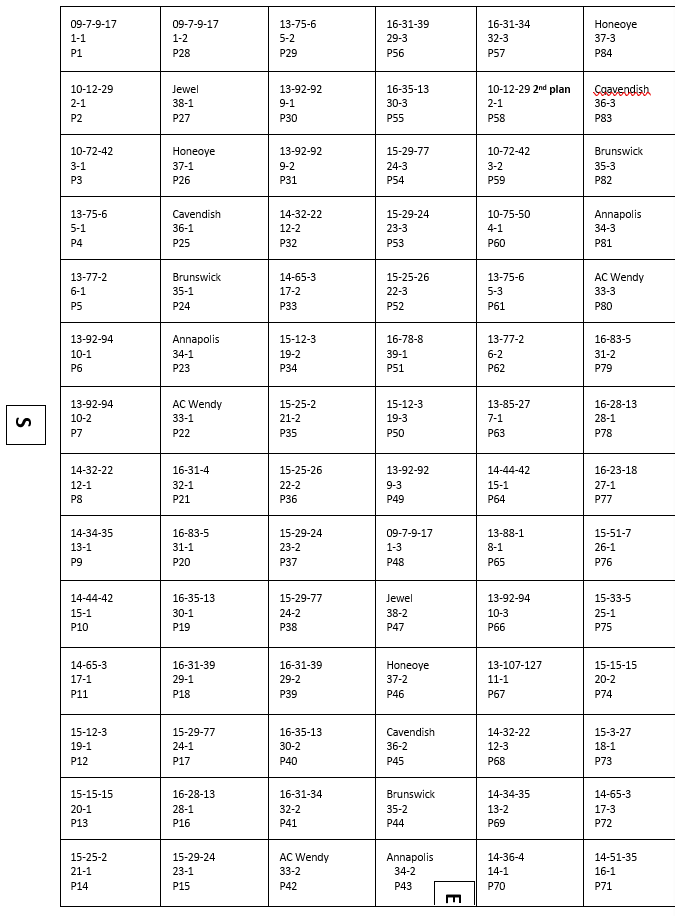
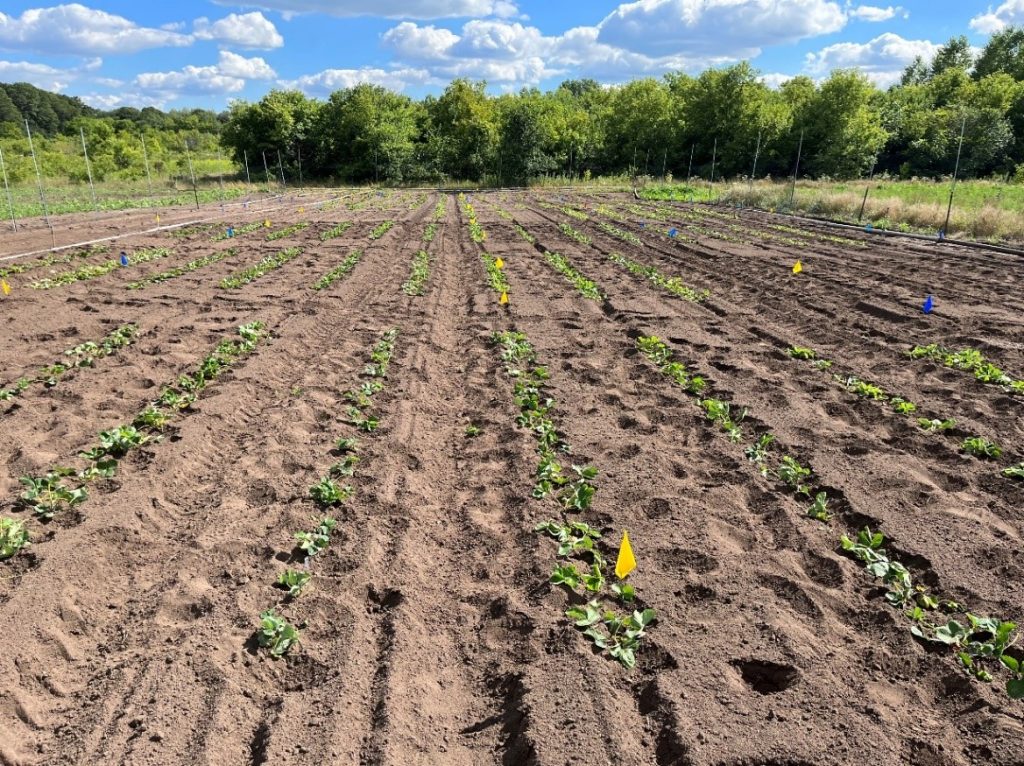
The strawberries in this trial are being grown under simulated commercial culture, except for minimal pest control (no disease sprays, 1-2 insecticide applications for tarnished plant bug and clipper weevil). Disease protection is not provided so as to obtain a clear view of susceptibility.
Data to be obtained include: Total fruit yield (kg/plot) per harvest date (allows us to characterize any differences in maturity/fruit yield concentration among cultivars), average fruit size (g/fruit) and fruit number, marketable yield (kg/plot), plant vigor (subjective numerical rating of 1-5; 1 = poor vigor, 5 = very vigorous, taken in June), plant stand (based on number of plants in 1m2/plot taken in September and May). This will allow us to characterize runnering tendencies and support documentation of winter survival ratings (fall vs. spring stands), and winter survival (subjective numerical rating of 1-5 taken 1 week post mulch removal) 1 = severe damage, 5 = no damage) More detailed subjective fruit characteristics such as firmness and flavor for each selection will be assigned a numerical rating also (please see all specifics below):
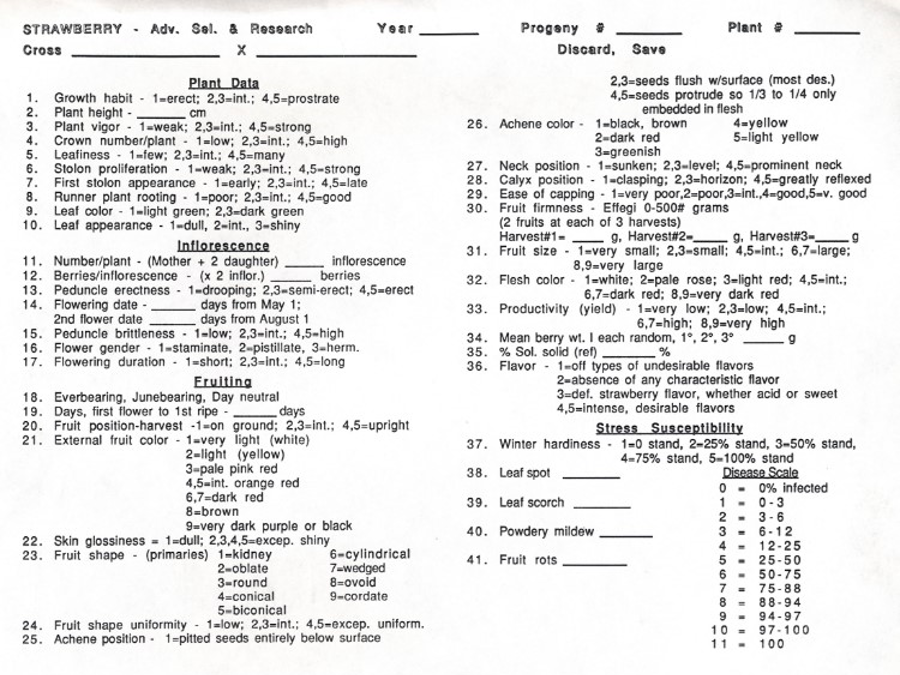
Another trial is planned next year for the 2018-2022 strawberry advanced selections.
This article was posted in Berries and tagged Brian Smith, Replicated Genotype Performance Trial, Strawberries, UW-River Falls Strawberry Research Update.
